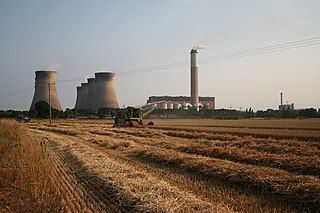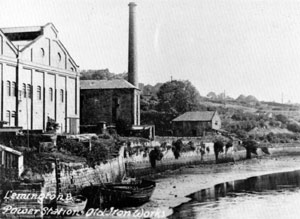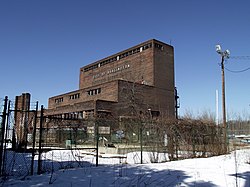
Burlington is the most populous city in the U.S. state of Vermont and the seat of Chittenden County. It is located 45 miles (72 km) south of the Canada–United States border and 95 miles (153 km) south of Montreal. As of the 2020 U.S. census, the population of the city was 44,743. It ranks as the least populous city in the United States to also be the most populous city in its state.

Battersea Power Station is a decommissioned Grade II* listed coal-fired power station, located on the south bank of the River Thames, in Nine Elms, Battersea, in the London Borough of Wandsworth. It was built by the London Power Company (LPC) to the design of Leonard Pearce, Engineer in Chief to the LPC, and CS Allott & Son Engineers. The architects were J. Theo Halliday and Giles Gilbert Scott. The station is one of the world's largest brick buildings and notable for its original, Art Deco interior fittings and decor.

A power station, also referred to as a power plant and sometimes generating station or generating plant, is an industrial facility for the generation of electric power. Power stations are generally connected to an electrical grid.

Bankside Power Station is a decommissioned electricity generating station located on the south bank of the River Thames, in the Bankside area of the Borough of Southwark, London. It generated electricity from 1891 to 1981. It was also used as a training base for electrical and mechanical student apprenticeships from all over the country. Since 2000 the building has been used to house the Tate Modern art museum and gallery.

The Richard L. Hearn Generating Station is a decommissioned electrical generating station in Toronto, Ontario, Canada. The plant was originally fired by coal, but later converted to burn natural gas. The plant has been described as "Pharaonic in scale", and encompasses 650 thousand cubic metres of space—large enough to fit 12 Parthenons inside.

A thermal power station is a type of power station in which heat energy is converted to electrical energy. In a steam-generating cycle heat is used to boil water in a large pressure vessel to produce high-pressure steam, which drives a steam turbine connected to an electrical generator. The low-pressure exhaust from the turbine enters a steam condenser where it is cooled to produce hot condensate which is recycled to the heating process to generate more high pressure steam. This is known as a Rankine cycle.

The Lakeview Generating Station was an Ontario Power Generation coal-burning station located in Lakeview, a community just east of Port Credit, in Mississauga, Ontario, Canada. The former station, constructed in 1958-1962, was located just east of Lakeshore Road and Cawthra Road. The four stacks of the station were known as the Four Sisters; the eight boilers of the generating plant all 'twinned' their emissions into common stacks. The station was a landmark for years and was shut down in April, 2005, after 43 years of service. The four stacks, which could be seen from as far away as Burlington to the west and downtown Toronto to the east, were demolished on June 12, 2006. The rest of the building was demolished on June 28, 2007.

Cottam power station is a decommissioned coal-fired power station. The site extends over 620 acres (250 ha) of mainly arable land and is situated at the eastern edge of Nottinghamshire on the west bank of the River Trent at Cottam near Retford. The larger coal-fired station, was decommissioned by EDF Energy in 2019 in line with the UK's goal to meet its zero-coal power generation by 2025. The smaller in-use station is Cottam Development Centre, a combined cycle gas turbine plant commissioned in 1999, with a generating capacity of 440 MW. This plant is owned by Uniper.

The Silahtarağa Power Station was a coal-fired generating station located in Istanbul Turkey. The Ottoman Empire's first power plant, it was in use from 1914 to 1983. The site has since been converted into a university campus for the Istanbul Bilgi University and houses two museums and several facilities. It was refurbished and renamed SantralIstanbul in 2007.

Lemington Power Station was a small, now demolished coal-fired power station, located in North East England. It was situated on the Lemington Gut, a backwater of the River Tyne, at Lemington, 3.5 mi (5.6 km) west of Newcastle upon Tyne. The station's main building stood until 2017 as a rare example of an early power station, dating from before the nationalisation of the United Kingdom's electrical supply industry.

Carville Power Station refers to a pair of now partially demolished coal-fired power stations, situated in North East England on the north bank of the River Tyne at Wallsend. The two stations were built alongside each other on a riverside site about 5 mi (8.0 km) downstream of Newcastle upon Tyne. Carville A Power Station, the first station on the site was opened in 1904, and Carville B Power Station was opened in 1916 to its south.

The Gould Street Generating Station was a former 100 MW electric generating plant operated by Exelon that was located on Gould Street in south Baltimore, Maryland, USA. The plant was adjacent to an elevated section of freeway I-95 and was south of the Riverside neighborhood and west of the Locust Point neighborhood of Baltimore. The plant site, located on the shore of the Middle Branch of the Patapsco River, was used for the generation of electric power for over one hundred years before being shut down on June 1, 2019. The site was purchased by Greenspring Realty Partners, Inc. for $3.1 million in December 2019. Demolition began in October 2020. The original brick buildings, the large storage tanks behind them, and other minor structures on the southwest portion of the property were demolished as of March 2021, but as of April 2022 the larger steel building to the northeast on the property remains. A large portion of the property was acquired by Weller Development in July 2021 and the future of the remaining structure and the property is not known.
Neptune Bank Power Station was a coal-fired power station situated on the River Tyne at Wallsend near Newcastle upon Tyne. Commissioned in 1901 by the Newcastle upon Tyne Electric Supply Company, the station was the first in the world to provide electricity for purposes other than domestic and street lighting. It was also the first in the world to generate electricity using three-phase electrical power distribution at a voltage of 5,500 volts.
Carrington Power Station is a combined cycle gas turbine power station, which was completed in Autumn 2016 and began commercial operation on 18 September 2016. It is located on the site of a former coal-fired power station, close to the villages of Carrington and Partington in the Greater Manchester Area and 12 km (7.5 mi) southwest of Manchester City Centre. The Manchester Ship Canal and the River Mersey run alongside the site, in Trafford, Greater Manchester, in North West England.

High Marnham Power Station was a coal-fired power station in Nottinghamshire, to the west of the River Trent, approximately 0.5 miles (0.8 km) north of the village of Marnham. Construction began in 1954, power generation commenced in 1959, and the station became fully operational in 1962. The plant operated until 2003 when it was decommissioned, though the cooling towers weren't demolished until 2012.
Close Power Station was a coal-fired power station situated on Newcastle upon Tyne's Quayside, in modern Tyne and Wear. The station was built by the Newcastle and District Electric Lighting Company in 1902, near their Forth Banks Power Station.

The Burlington Electric Department (BED) is a municipally-owned electric utility of Burlington, Vermont. It is the largest municipally-owned electric utility in Vermont. It has over 19,600 customers. It is the only utility providing electricity to the city and the Burlington International Airport.

The Seaholm Power Plant is a historic former power station located on the north shore of Lady Bird Lake in Downtown Austin, Texas. Opened in 1951, it is listed on the National Register of Historic Places and designated as a Recorded Texas Historic Landmark. The power plant ceased operation in 1996, and the facility and site were later redeveloped into a mixed-use district.
The Worcester Power Stations were a series of hydro-electric and coal-fired generating stations providing electricity to the City of Worcester.
Blackburn power stations are a series of electricity generating stations that have provided electric power to the town of Blackburn and the wider area from 1895 to the present. The first station in Jubilee Street, Blackburn began operating in 1895. A new larger station known as Blackburn East or Whitebirk power station was commissioned in 1921 and was rebuilt in stages over the period 1942 to 1955. Whitebirk station closed in 1976. The 60 MW Blackburn Mill Combined Cycle Gas Turbine (CCGT) power station has generated electricity since 2002. The Blackburn energy from waste (EfW) plant is currently (2020) being planned.

















